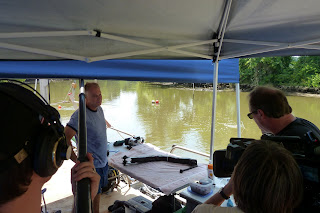By Michael English, Producer
(On the river near Wayson's Corner, Md.) -- At low tide here, a white stripe dries pale and jagged on shoreline river brush, looking a little like it was painted on. For those who know, it tells the important tale of the last Patuxent high tide. It's an easy code to break. It simply remembers the most recent high water mark -- a convenient reminder of a never-ending cycle that drops the river nearly two feet in just a few hours. Pay no attention, and you can find yourself high and dry on river mud, waiting.
In the afternoon, Videographer Marlene Rodman was busy composing shots of shoreline mud flats when Bob Neyland suddenly surfaced. I could see he had something. Marlene swung around to catch the shot. Just then, someone switched off the lone dredge pump that was keeping sediment from re-blanketing the wreck's bow section. Now it was possible to capture audio as well, and Audio Engineer Gordon Masters extended his fish pole to catch it all.
We'd been waiting for Neyland. He'd been in the water for nearly an hour, accompanied by fellow Principal Investigator Julie Schablitsky. We learned later they had worked carefully, methodically -- almost tediously -- in the murky water to free a part of the wreck that was loose and in danger of being swept away by the Patuxent's relentless current. Now, Neyland floated it gently along the surface to the barge ladders, then passed it up. It was brought aboard and immediately measured, drawn, cataloged and then re-immersed in riverwater to keep it from the open air.
Exactly what it is has yet to be determined, but Neyland believes it could be a Cathead -- a large piece of wood angled at 45 degrees that helps to hold a ship's anchor in place. But this wasn't an artifact from just any ship. This ship could possibly be the USS Scorpion -- Joshua Barney's flagship during the War of 1812. It was an exciting discovery -- the first identifiable piece of the ship itself that the crew and I had seen in our three days aboard the barge. Busy as he was, Neyland gave us a good interview describing conditions below and the work it took to free the artifact from the wreck but, then -- like all of them -- so busy here at this site from morning until evening, he and the rest of his archeological team moved on to the next artifact to be cataloged, drawn or conserved. This afternoon's discovery was special, yes, but there was more to be done and little time to do it.
But for us -- the uninitiated, witnessing history as it's made and getting caught up in it all -- it feels a little like a whisper from August 22, 1814, the last time our mystery ship sailed this winding channel and its brave sailors, with enemies nearby, kept a close eye on the tide line.




No comments:
Post a Comment